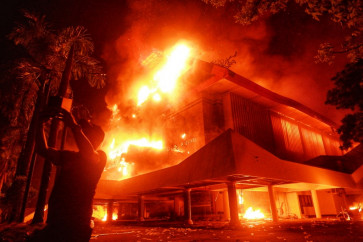Popular Reads
Top Results
Can't find what you're looking for?
View all search resultsPopular Reads
Top Results
Can't find what you're looking for?
View all search resultsJokowi's sustainable community-based forest management
Ideas for communitybased forest management (CBFM) have emerged since the 1970s, but movements to support this, mainly by NGOs, began in 1995
Change text size
Gift Premium Articles
to Anyone
I
deas for communitybased forest management (CBFM) have emerged since the 1970s, but movements to support this, mainly by NGOs, began in 1995. After a long journey of struggle to convince various parties, finally the ideas have fallen in fertile soil under the current government.
The Environment and Forestry Ministry will distribute 12.7 million hectares to indigenous peoples (IP). To support this, President Joko 'Jokowi' Widodo will establish a task force to protect the rights of indigenous people and preserve their customary lands and actively participate in the ratification of
the draft of the Indigenous Peoples' Rights Acknowledgment and Protection Bill (The Jakarta Post, Aug. 1, 2015). It is hoped that the program will run smoothly as planned.
The next important question is, however, what the people will do with their new rights and authorities, how they will use these to create better lives for themselves in a lasting way, and what this means for forests and ecosystems under their control.
This probably means a lot of additional efforts beyond the already complicated land issues ' in the worst scenario they will cash out the land for short-term income gain. Its generating purposes will be not much different from past concessionaires' doings and that will be disappointing to all.
So far, this issue has not been sufficiently addressed, though not ignored. Most CBFM supporters are very confident that in the hands of IP, forest resource management would be done sustainably. They generally rely on the romantics of IP in managing forest resources during the old days.
IP used to manage their resources with a spirit of communality; IP have strong bonds to their ancestral domains, making them more responsible in sustaining the forest. IP also have indigenous knowledge which can be a basis for achieving sustainable forest management.
However, times have changed. Media, communications and situations have changed. Sooner or later most IP will change due to the storm influence of materialism and individualistic culture. CBFM supporters should be aware of this to avoid false assumptions and improper actions.
The challenges in developing CBFM are twofold: internal IP institutions and strong external opportunists that work in the absence of honest facilitators. The weaknesses of IP institutions are especially a lack of conflict resolution mechanisms and enforcement systems.
Some IP cannot easily adapt to new changes and opportunities ' the limits of technology and methodology to manage forests sustainably, economics of scale, investment and even for simple forest operations of harvesting and planting.
While on the contrary, the opportunists keep promoting consumerism and short-term ideals.
Learning from the success story of smallholder oil-palm plantation development, CBFM should be designed by taking into consideration the following factors: Economic scale of CBFM areas both for individuals and community groups; selection of key commodities to guarantee sustainable incomes for short, medium and long periods; market security indicated by long-term partnerships with the private sector; the establishment of a processing industry for key CBFM products; and tripartite (corporate, IP, government) price determination.
To be sustainable, CBFM should implement the following strategies:
First, delineate and map the potential opportunities of CBFM priority commodities (agar wood, honeybees, rattan, palm sugar, benzoin, chestnut, rubber, fast-growing tree species etc.) and the potential linkages to markets/processing industries.
The map could be prepared by research agencies in collaboration with the Customary Areas Registration Agency (BRWA), established by the executive board of the Alliance of Indigenous Peoples (AMAN) working with the Participatory Mapping Network (JKKP) and Forest Watch Indonesia (FWI).
Second, considering the slow progress of CBFM in the past, government and NGOs need to identify the obstacles, best practices and lessons learned to redefine strategies to accelerate a CBFM program.
Third, considering the diverse IP capacity and specific cultural challenges, government, NGOs and relevant stakeholders have to develop strategies and define field facilitators responsible for establishing and strengthening community institutions and conflict resolution at the grassroots level.
Fourth, considering the need to develop economically viable and environmentally sustainable CBFM models, the government and NGOs have to develop a roadmap on economic infrastructure development to support sustainable livelihoods.
And most important is to find suitable private sector players that voluntarily provide their capacity to help, facilitate and collaborate.
It is now time to implement the real spirit of gotong royong (togetherness). The time has come for NGOs, research organizations, universities and private sector organizations to provide direction, facilitation and technical assistance and to work hand-in-hand with the government at the central, provincial and district levels and IP to build sustainable CBFM models.
Building sustainable livelihoods is the key to prevent land ownership transfer from IP to sly opportunist actors/agents. Regulation and promotion alone will not be sufficient.
People need genuine leadership and to be easily understood on the ground. It is time for our forester President to make forestry properly managed by the people for the benefit of the people.
________________
IP have strong bonds to their ancestral domains, making them more responsible in sustaining the forest.
________________
The writer is director of the Tropenbos International Indonesia Program, Bogor, West Java.










